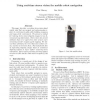Free Online Productivity Tools
i2Speak
i2Symbol
i2OCR
iTex2Img
iWeb2Print
iWeb2Shot
i2Type
iPdf2Split
iPdf2Merge
i2Bopomofo
i2Arabic
i2Style
i2Image
i2PDF
iLatex2Rtf
Sci2ools
AROBOTS
2000
2000
Using Real-Time Stereo Vision for Mobile Robot Navigation
This paper describes a working stereo-vision-based mobile robot that can navigate and autonomously explore its environment safely while building occupancy grid maps of the environment. We present a method for reducing stereo vision disparity images to two dimensional map information. Stereo vision has several attributes that set it apart from other sensors more commonly used for occupancy grid mapping. We discuss these attributes, the errors that some of them create, and how to overcome them. This includes the idea of segmenting disparity images based on continuous disparity surfaces to reject "spikes" caused by stereo mismatches. Stereo vision processing and map updates are done at 5Hz and the robot moves at speeds of 150 cm/s.
| Added | 17 Dec 2010 |
| Updated | 17 Dec 2010 |
| Type | Journal |
| Year | 2000 |
| Where | AROBOTS |
| Authors | Don Murray, James J. Little |
Comments (0)

